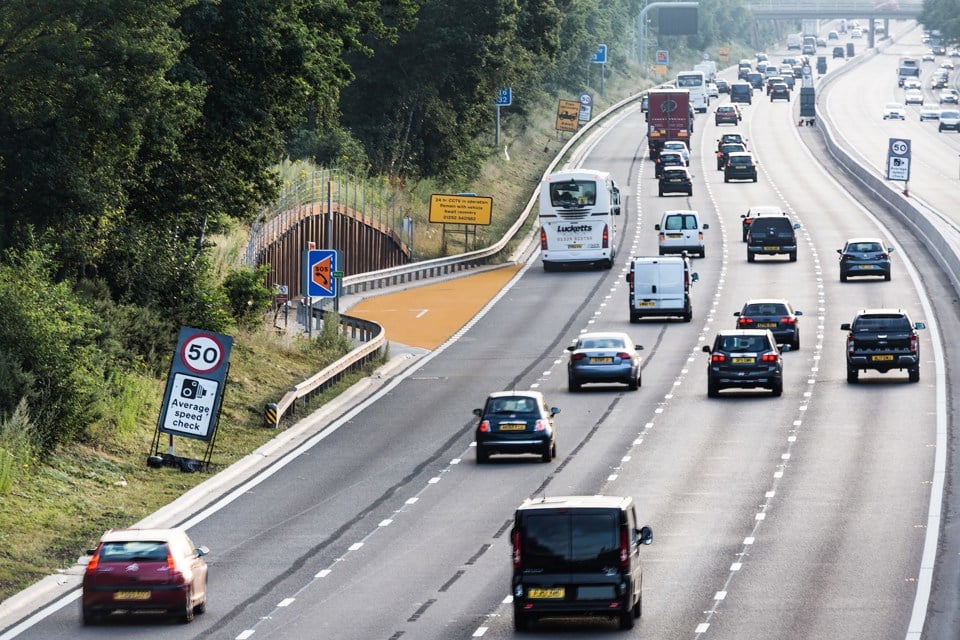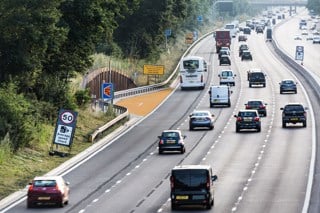The Department for Transport (DfT) is halting the rollout of new, all-lane running smart motorway schemes until five years of safety data is available.
The move has been welcomed by MPs and campaigners, who have been calling for the construction of new smart motorways to be paused while safety concerns were addressed.
A Transport Committee report, published last year, concluded there was not enough safety and economic data to justify continuing with the Government’s plans to roll out an additional 300 miles of all-lane running motorway by 2025.
The report said Government plans to remove the hard shoulder from all future smart motorways and use the lane for live traffic are "premature".
"This watershed decision is an unqualified victory for drivers," Nicholas Lyes, RAC
Publishing its response to that highly critical report today (Wednesday, January 12), the Government says the rollout of new smart motorway schemes will be paused until a full five years’ worth of safety data becomes available for schemes introduced before 2020, and the DfT will invest £900 million to improve safety on existing all-lane running (ALR) motorways.
Transport secretary Grant Shapps said: “I am grateful to the Transport Committee and to all those who provided evidence for its work.
“While our initial data shows that smart motorways are among the safest roads in the UK, it’s crucial that we go further to ensure people feel safer using them.
“Pausing schemes yet to start construction and making multimillion-pound improvements to existing schemes will give drivers confidence and provide the data we need to inform our next steps.
“I want to thank safety campaigners, including those who have lost loved ones, for rightly striving for higher standards on our roads. I share their concerns.”
The Government says it will ensure that current smart motorways without a permanent hard shoulder are equipped with “best-in-class” technology and resources to make them as safe as possible.
This will include investing £390m to install more than 150 additional emergency areas so drivers have more places to stop if they get into difficulty. This will represent around a 50% increase in places to stop by 2025.
DfT has welcomed the Transport Committee’s report, which endorsed its focus on further upgrading the safety of existing ALR smart motorways rather than reinstating the hard shoulder.
As concluded by the committee, evidence suggests hard shoulders do not always provide a safe place to stop, and by reducing motorway capacity, they could put more drivers and passengers at risk of death or serious injury if they were to divert onto less safe local roads.
However, while DfT will be taking forward all the recommendations set out in the transport committee’s report, it does not agree with the view that smart motorways were rolled out prematurely or unsafely.
All ALR smart motorway schemes are, and will continue to be, subject to high standards of design, risk assessment and construction, followed by detailed monitoring and evaluation once opened to traffic, it says.
While further data is being collected, National Highways will continue work to complete schemes that are currently in construction, which will all open with technology in place to detect stopped vehicles.
These schemes are all more than 50% completed and halting progress on them now would cause significant disruption for drivers, said the DfT.
Design work will also continue on those schemes already being planned, so they are ready to be constructed depending on the outcome of the pause. No preparatory construction work will take place.
Also, in line with the committee’s recommendations, National Highways will pause the conversion of dynamic hard shoulder (DHS) motorways – where the hard shoulder is open at busy times – into all lane running motorways while it investigates alternative ways of operating them to make things simpler for drivers.
National Highways will also install technology to detect stopped vehicles on these sections.
National Highways CEO Nick Harris said: “We have listened to public concerns about smart motorways and we are fully committed to taking forward the additional measures the Transport Committee has recommended.
“While we pause those all lane running schemes yet to start construction, we will complete the schemes currently in construction.
“We will make existing sections as safe as they can possibly be and we will step up our advice to drivers so they have all the information they need.
“We are doing this because safety is our absolute priority and we want drivers to not just be safer, but also to feel safe on our busiest roads.”
The Government says that today’s announcement builds on the progress already made against DfT’s 18-point action plan to improve smart motorway safety, announced in March 2020, including adding emergency areas and upgrading cameras to detect red X offences.
RAC head of roads policy Nicholas Lyes said: “This watershed decision is an unqualified victory for drivers, many of whom have deeply held concerns over the safety of motorways where the hard shoulder is permanently removed.
“Rather than ploughing on regardless in the face of mounting public opposition, we’re pleased the Government has finally hit the pause button and given itself time to fully consider the safety of these schemes, and the way our motorways are adapted to increase capacity from now on.”
Lyes says that the commitment to install an additional 150 refuge areas on existing schemes to bring them all up to the same standard is “positive news” and should go some way towards reassuring drivers worried about reaching one in an emergency.
“The safety of our motorway network is paramount and no policy decisions should ever risk making our fastest roads less safe,” he added.
“Today’s decision to review a full five years of all the safety data and to look at all possible options with a fresh perspective should ensure our motorways can accommodate increased traffic volumes safely and – just as importantly – that the drivers using them feel safe doing so.”
The key concern for the AA in its decade-long campaign to improve the safety of ‘smart’ motorways has been that more than a third (38%) of breakdowns on smart motorways occur in live lanes.
The commitment to 150 new ERAs, alongside better technology, aims to reduce that risk.
The original M42 pilot in 2006 worked quite well as refuges were only 400/500m apart but the roll-out with refuges at 2,500m apart, without decent technology, meant that lives have been put at risk, says the AA.
It is also encouraging the Transport Secretary to further investigate ’controlled’ motorways which have a hard shoulder and all the gantry technology but are deemed to be the safest type of motorway.
The committee also called for their safety and economic case to be reviewed for future schemes.
Edmund King, AA president, said: “We would like further investigation, which the transport secretary has agreed to, of our proposal for all-lane running schemes to revert to the hard-shoulder between 7pm-7am to avoid confusion and to offer a refuge to counter live lane collisions that happen at night.”
He added: “We are pleased our call for better evaluation of the Stopped Vehicle Detection technology has been accepted but still question why it wasn’t fitted before schemes opened.
“The AA view remains that controlled motorways with a hard shoulder are the safest option and we are pleased that the business case for these will be examined.”
The Royal Society for the Prevention of Accidents (RoSPA) has been calling for an increase in the number of emergency refuge areas on ALR smart motorways. Rebecca Needham, road safety officer at RoSPA, said she was pleased to see the DfT has committed to a retrofit a further 150 emergency refuge areas to existing schemes.
“It is vitally important that a programme to retrofit emergency refuges on ALR motorways is put in place, because between 2015 and 2019, 39 people died on UK smart motorways, according to figures from National Highways," she added.
“Currently on ALR motorways, the emergency refuges are spaced at up to 1.6 miles apart. Today's report adopts RoSPA’s recommendation to reduce the distance between safe stopping places on ALR motorways to a maximum of 1,500 metres and down to 1,000 metres (0.75 miles) where physically possible."
National Highways says it will ramp up communications so drivers have better information about how to drive on smart motorways.






















Login to comment
Comments
No comments have been made yet.